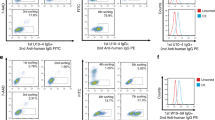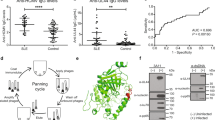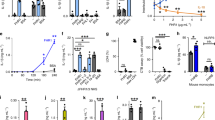Abstract
Systemic sclerosis is an autoimmune disease characterized by immunological and vascular abnormalities. Autoantibodies against intracellular antigens are associated with particular clinical features of the disease1, whereas autoantibodies against cell surface antigens may be pathogenic by inducing endothelial cell damage2,3, considered the primary event in the pathogenesis of the disease. Latent human cytomegalovirus infection may contribute to progression of systemic sclerosis through its ability to infect endothelial cells4; however, direct links between human cytomegalovirus infection and systemic sclerosis are still lacking5. Molecular mimicry is one of the mechanisms that account for the link between infection and autoimmunity6,7,8. Here we have identified an immunodominant peptide using systemic sclerosis serum screening of a random peptide library; such peptide shares homology with autoantigens and with the human cytomegalovirus late protein UL94 (ref. 9). Immunoglobulin G antibodies against the peptide affinity-purified from the sera of patients with systemic sclerosis specifically recognized the viral product and autoantigens; moreover, such antibodies induced endothelial cell apoptosis through specific interaction with the cell surface integrin–NAG-2 protein complex10. Our results provide evidence that antibodies against human cytomegalovirus cause apoptosis of endothelial cells11, considered the initial pathogenic event of systemic sclerosis, and indicate a previously unknown mechanism for the etiological link between human cytomegalovirus infection and autoimmunity.
This is a preview of subscription content, access via your institution
Access options
Subscribe to this journal
Receive 12 print issues and online access
$209.00 per year
only $17.42 per issue
Buy this article
- Purchase on Springer Link
- Instant access to full article PDF
Prices may be subject to local taxes which are calculated during checkout



Similar content being viewed by others
References
Harvey, G.R. & McHugh, N.J. Serologic abnormalities in systemic sclerosis. Curr. Opin. Rheumatol. 11, 495–502 (1999).
Bordron, A. et al. The binding of some human antiendothelial cell antibodies induces endothelial cell apoptosis. J. Clin. Invest. 101, 2029–2035 (1998).
Carvalho, D., Savage, O.S., Black, C.M. & Pearson, J.D. IgG antiendothelial cell autoantibodies from scleroderma patients induce leukocyte adhesion to human vascular endothelial cells in vitro. J. Clin. Invest. 97,111–119 (1996).
Pandey, J.P. & LeRoy, E.C. Human cytomegalovirus and the vasculopathies of autoimmune diseases (expecially scleroderma), allograft rejection and coronary restenosis. Arthritis Rheum. 41, 10–15 (1998).
Neidhart, M. et al. Increased serum levels of antibodies against cytomegalovirus and prevalence of autoantibodies in systemic sclerosis. Arthritis Rheum. 42, 389–392 (1999).
Di Rosa, F. & Barnaba, V. Persisting viruses and chronic inflammation: understanding their relation to autoimmunity. Immunol. Rev. 164,17–27 (1998).
Wucherpfennig, K.W. & Strominger, J.L. Molecular mimicry in T cell-mediated autoimmunity: viral peptides activate human T cell clones specific for myelin basic protein. Cell. 80, 695–705 (1995).
Zhao, Z.S., Granucci, F., Yeh, L., Schaffer, P.A. & Cantor, H. Molecular mimicry by herpes symplex virus-type 1: autoimmune disease after viral infection. Science 279, 1344–1347 (1998).
Wing, B.A., Lee, G.C.Y. & Huang, E. The human cytomegalovirus UL94 open reading frame encodes a conserved herpesvirus capsid/tegument-associated virion protein that is expressed with true late kinetics. J. Virol. 70, 3339–3345 (1996).
Tachibana, I., Bodorova, J., Berditchevski, F., Zutter, M.M. & Helmer, M. E. NAG-2, a novel transmembrane-4 superfamily (TM4SF) protein that complexes with integrins and other TM4SF proteins. J. Biol. Chem. 272, 29181–29189 (1997).
Sgonc, R. et al. Endothelial cell apoptosis is a primary pathogenetic event underlying skin lesions in avian and human scleroderma. J. Clin. Invest. 98, 785–792 (1996).
Scott, J.K. & Smith, G.P. Searching for peptide ligands with an epitope library. Science, 249, 386–390 (1990).
Devlin, J.J., Panganiban, L.C. & Devlin, P.E. Random peptide libraries: a source of specific protein binding molecules. Science 249, 404–406 (1990).
Bowditch, R.D., Tani, P., Fong, K.C. & Mc Millan, R. Characterization of autoantigenic epitopes on platelet glycoprotein IIb/IIIa using random peptide libraries. Blood 12, 4579–4584 (1996).
Sibille, P. et al. Mimotopes of polyreactive anti-DNA antibodies identified using phage-display peptide libraries. Eur. J. Immunol. 27, 1221–1228 (1997).
Rose, N.R. The role of infection in the pathogenesis of autoimmune disease. Sem. Immunol. 10, 5–13 (1998).
Shahgasempour, S., Woodroffe, S.B., Sullivan-Tailyour, G. & Garnett, H.M. Alteration in the expression of endothelial cell integrin receptors α5β1 and α2β1 and alpha6 beta1 after in vitro infection with a clinical isolate of human cytomegalovirus. Arch. Virol. 142, 125–138 (1997).
Wellings, D. A. & Atherton, E. Standard FMOC protocols. Meth. Enzymol. 289, 44–67 (1997).
Lunardi, C. et al. Chronic parvovirus B19 infection induces the production of anti-virus antibodies with autoantigen binding properties. Eur. J. Immunol. 28, 936–948 (1998).
Madaio, M.P., Fabbi, M., Tiso, M., Daga, A. & Puccetti, A. Spontaneously produced anti-DNA/DNase I autoantibodies modulate nuclear apoptosis in living cells. Eur. J. Immunol. 26, 3035–3041 (1996).
Acknowledgements
The authors thank R.S. Schwartz for criticism and suggestions and for revising the manuscript; A. Celi, R. Bonfanti and C. Bottino for discussions; M. Nanni for help in analyzing and elaborating the experimental data; and B. Maloberti for secretarial assistance. This work was supported by grants from Regione Veneto, Ricerca Finalizzata Venezia-Italia (C.L.), the Associazione Italiana per la Ricerca sul Cancro (A.P.) and Cariverona Foundation (R.C.).
Author information
Authors and Affiliations
Corresponding author
Rights and permissions
About this article
Cite this article
Lunardi, C., Bason, C., Navone, R. et al. Systemic sclerosis immunoglobulin G autoantibodies bind the human cytomegalovirus late protein UL94 and induce apoptosis in human endothelial cells. Nat Med 6, 1183–1186 (2000). https://doi.org/10.1038/80533
Received:
Accepted:
Issue Date:
DOI: https://doi.org/10.1038/80533
This article is cited by
-
The target on B cells in Systemic Sclerosis: a “midsummer dream” to extinguish inflammation and prevent early disease progression to fibrosis
Clinical Rheumatology (2021)
-
Current Concepts on the Pathogenesis of Systemic Sclerosis
Clinical Reviews in Allergy & Immunology (2021)
-
A study of antigen-specific anti-cytomegalovirus antibody reactivity in patients with systemic sclerosis and concomitant anti-Ro52 antibodies
Rheumatology International (2020)
-
Identification of a novel autoantibody against self-vimentin specific in secondary Sjögren’s syndrome
Arthritis Research & Therapy (2018)
-
Unmet Needs in Systemic Sclerosis Understanding and Treatment: the Knowledge Gaps from a Scientist’s, Clinician’s, and Patient’s Perspective
Clinical Reviews in Allergy & Immunology (2018)



